Financial Accounting Assignment: IAS 10, Share Capital, and Impairment
VerifiedAdded on 2021/02/19
|10
|2378
|40
Homework Assignment
AI Summary
This financial accounting assignment solution addresses several key areas of financial reporting. It begins with an analysis of events occurring after the balance sheet date, as per IAS 10, determining whether transactions are adjustable or non-adjustable and providing corresponding journal entries. The solution then delves into accounting for share capital, including journal entries for share applications, allotments, share issue expenses, share calls, forfeitures, and reissuance of shares. A detailed explanation and calculations are provided for the deferred tax worksheet. The assignment also covers the revaluation model for fixed assets, including journal entries for increases and decreases in asset values, and discusses impairment and subsequent reversal of assets, explaining the application and allocation of impairment tests and losses. The solution encompasses a range of financial accounting principles and practical applications, making it a valuable resource for students.

FINANCIAL ACCOUNTING
Paraphrase This Document
Need a fresh take? Get an instant paraphrase of this document with our AI Paraphraser
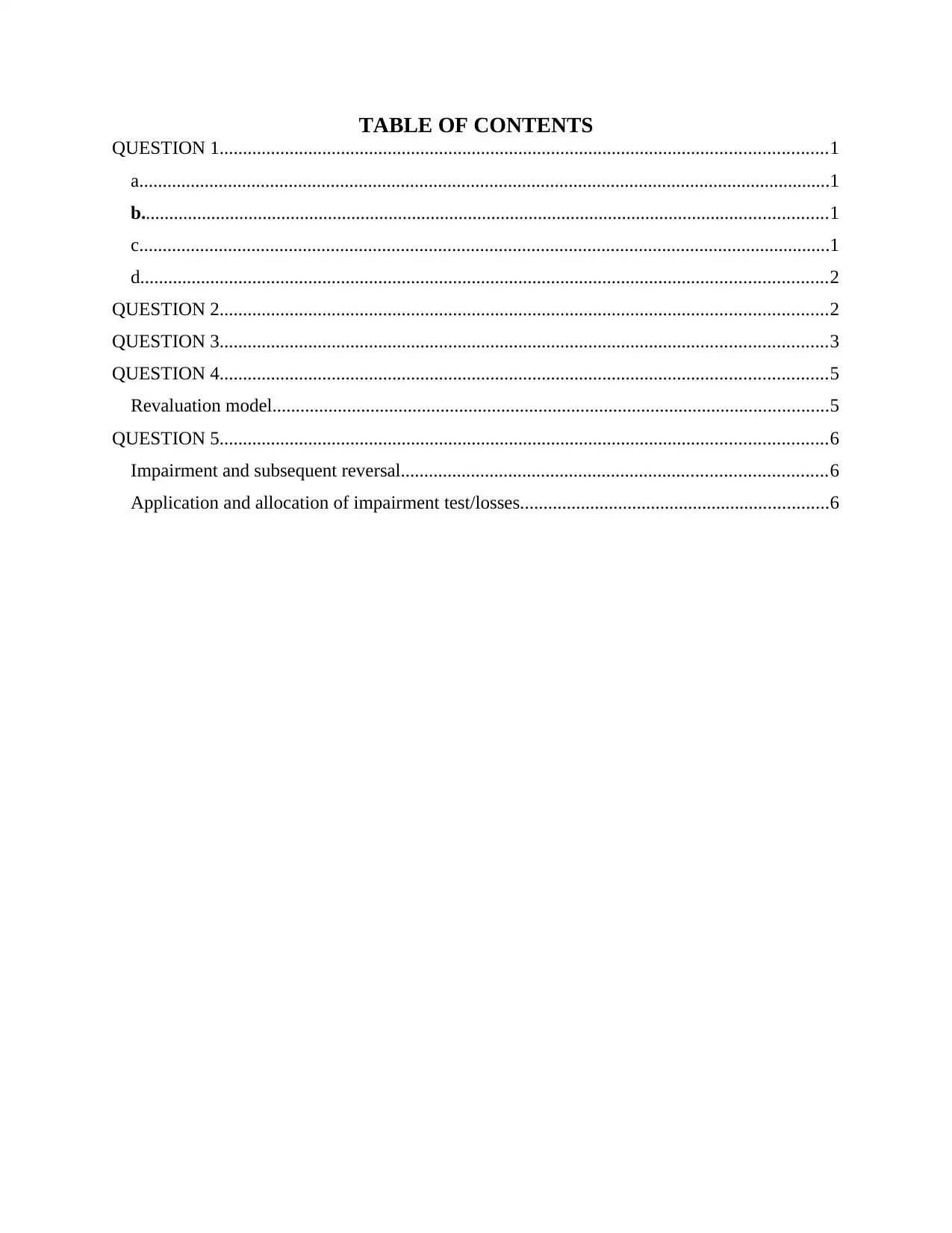
TABLE OF CONTENTS
QUESTION 1..................................................................................................................................1
a....................................................................................................................................................1
b...................................................................................................................................................1
c....................................................................................................................................................1
d...................................................................................................................................................2
QUESTION 2..................................................................................................................................2
QUESTION 3..................................................................................................................................3
QUESTION 4..................................................................................................................................5
Revaluation model.......................................................................................................................5
QUESTION 5..................................................................................................................................6
Impairment and subsequent reversal...........................................................................................6
Application and allocation of impairment test/losses..................................................................6
QUESTION 1..................................................................................................................................1
a....................................................................................................................................................1
b...................................................................................................................................................1
c....................................................................................................................................................1
d...................................................................................................................................................2
QUESTION 2..................................................................................................................................2
QUESTION 3..................................................................................................................................3
QUESTION 4..................................................................................................................................5
Revaluation model.......................................................................................................................5
QUESTION 5..................................................................................................................................6
Impairment and subsequent reversal...........................................................................................6
Application and allocation of impairment test/losses..................................................................6
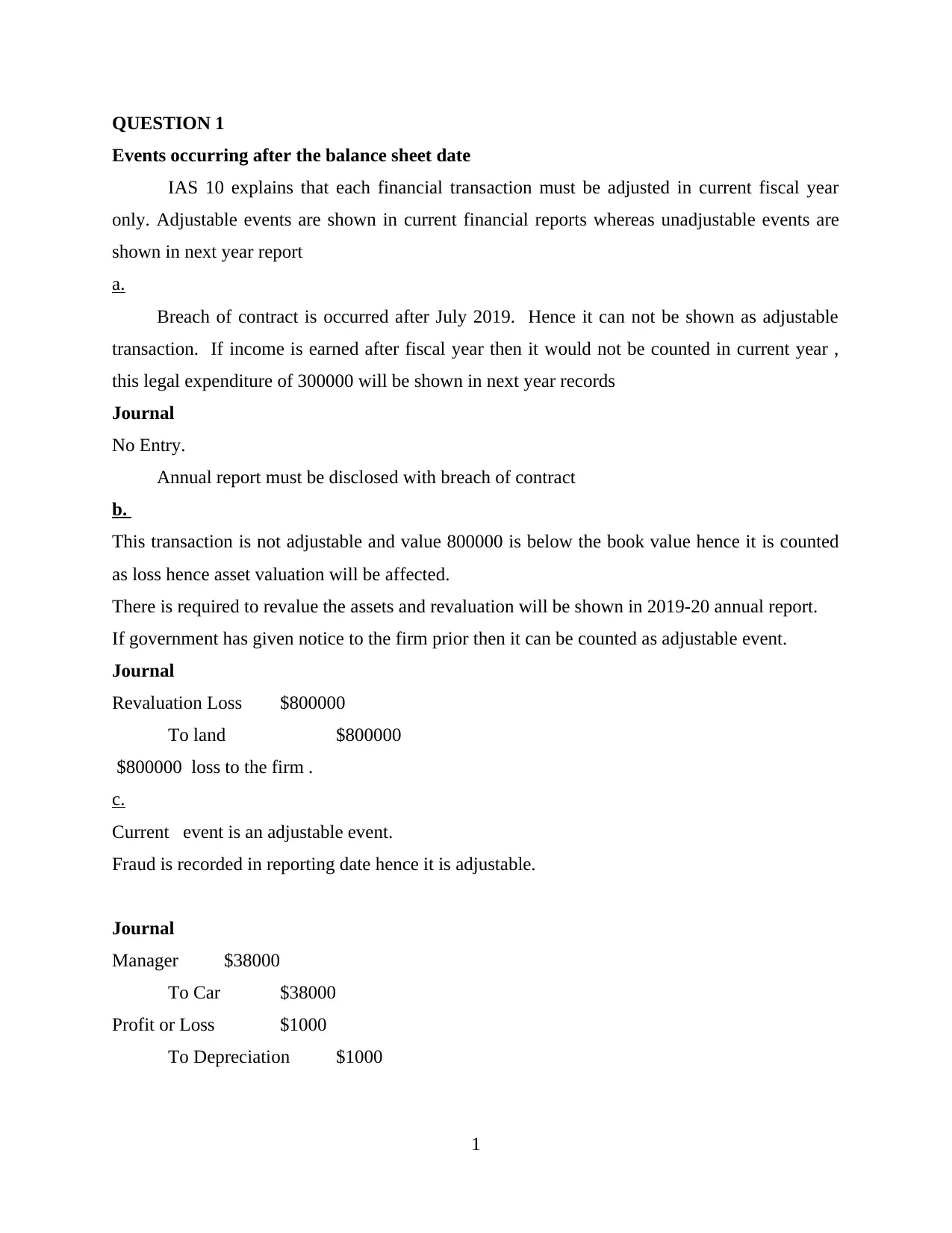
QUESTION 1
Events occurring after the balance sheet date
IAS 10 explains that each financial transaction must be adjusted in current fiscal year
only. Adjustable events are shown in current financial reports whereas unadjustable events are
shown in next year report
a.
Breach of contract is occurred after July 2019. Hence it can not be shown as adjustable
transaction. If income is earned after fiscal year then it would not be counted in current year ,
this legal expenditure of 300000 will be shown in next year records
Journal
No Entry.
Annual report must be disclosed with breach of contract
b.
This transaction is not adjustable and value 800000 is below the book value hence it is counted
as loss hence asset valuation will be affected.
There is required to revalue the assets and revaluation will be shown in 2019-20 annual report.
If government has given notice to the firm prior then it can be counted as adjustable event.
Journal
Revaluation Loss $800000
To land $800000
$800000 loss to the firm .
c.
Current event is an adjustable event.
Fraud is recorded in reporting date hence it is adjustable.
Journal
Manager $38000
To Car $38000
Profit or Loss $1000
To Depreciation $1000
1
Events occurring after the balance sheet date
IAS 10 explains that each financial transaction must be adjusted in current fiscal year
only. Adjustable events are shown in current financial reports whereas unadjustable events are
shown in next year report
a.
Breach of contract is occurred after July 2019. Hence it can not be shown as adjustable
transaction. If income is earned after fiscal year then it would not be counted in current year ,
this legal expenditure of 300000 will be shown in next year records
Journal
No Entry.
Annual report must be disclosed with breach of contract
b.
This transaction is not adjustable and value 800000 is below the book value hence it is counted
as loss hence asset valuation will be affected.
There is required to revalue the assets and revaluation will be shown in 2019-20 annual report.
If government has given notice to the firm prior then it can be counted as adjustable event.
Journal
Revaluation Loss $800000
To land $800000
$800000 loss to the firm .
c.
Current event is an adjustable event.
Fraud is recorded in reporting date hence it is adjustable.
Journal
Manager $38000
To Car $38000
Profit or Loss $1000
To Depreciation $1000
1
⊘ This is a preview!⊘
Do you want full access?
Subscribe today to unlock all pages.

Trusted by 1+ million students worldwide
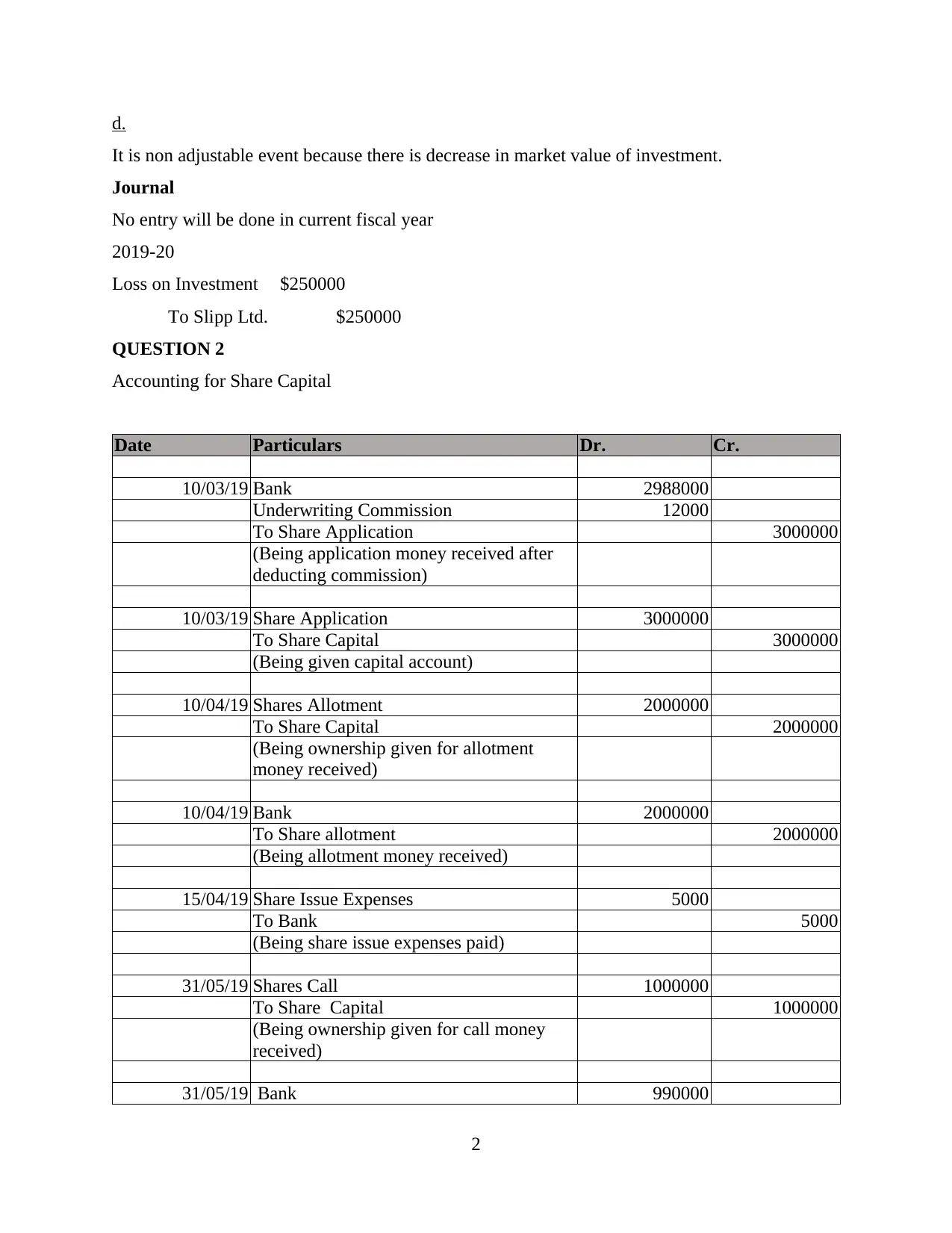
d.
It is non adjustable event because there is decrease in market value of investment.
Journal
No entry will be done in current fiscal year
2019-20
Loss on Investment $250000
To Slipp Ltd. $250000
QUESTION 2
Accounting for Share Capital
Date Particulars Dr. Cr.
10/03/19 Bank 2988000
Underwriting Commission 12000
To Share Application 3000000
(Being application money received after
deducting commission)
10/03/19 Share Application 3000000
To Share Capital 3000000
(Being given capital account)
10/04/19 Shares Allotment 2000000
To Share Capital 2000000
(Being ownership given for allotment
money received)
10/04/19 Bank 2000000
To Share allotment 2000000
(Being allotment money received)
15/04/19 Share Issue Expenses 5000
To Bank 5000
(Being share issue expenses paid)
31/05/19 Shares Call 1000000
To Share Capital 1000000
(Being ownership given for call money
received)
31/05/19 Bank 990000
2
It is non adjustable event because there is decrease in market value of investment.
Journal
No entry will be done in current fiscal year
2019-20
Loss on Investment $250000
To Slipp Ltd. $250000
QUESTION 2
Accounting for Share Capital
Date Particulars Dr. Cr.
10/03/19 Bank 2988000
Underwriting Commission 12000
To Share Application 3000000
(Being application money received after
deducting commission)
10/03/19 Share Application 3000000
To Share Capital 3000000
(Being given capital account)
10/04/19 Shares Allotment 2000000
To Share Capital 2000000
(Being ownership given for allotment
money received)
10/04/19 Bank 2000000
To Share allotment 2000000
(Being allotment money received)
15/04/19 Share Issue Expenses 5000
To Bank 5000
(Being share issue expenses paid)
31/05/19 Shares Call 1000000
To Share Capital 1000000
(Being ownership given for call money
received)
31/05/19 Bank 990000
2
Paraphrase This Document
Need a fresh take? Get an instant paraphrase of this document with our AI Paraphraser
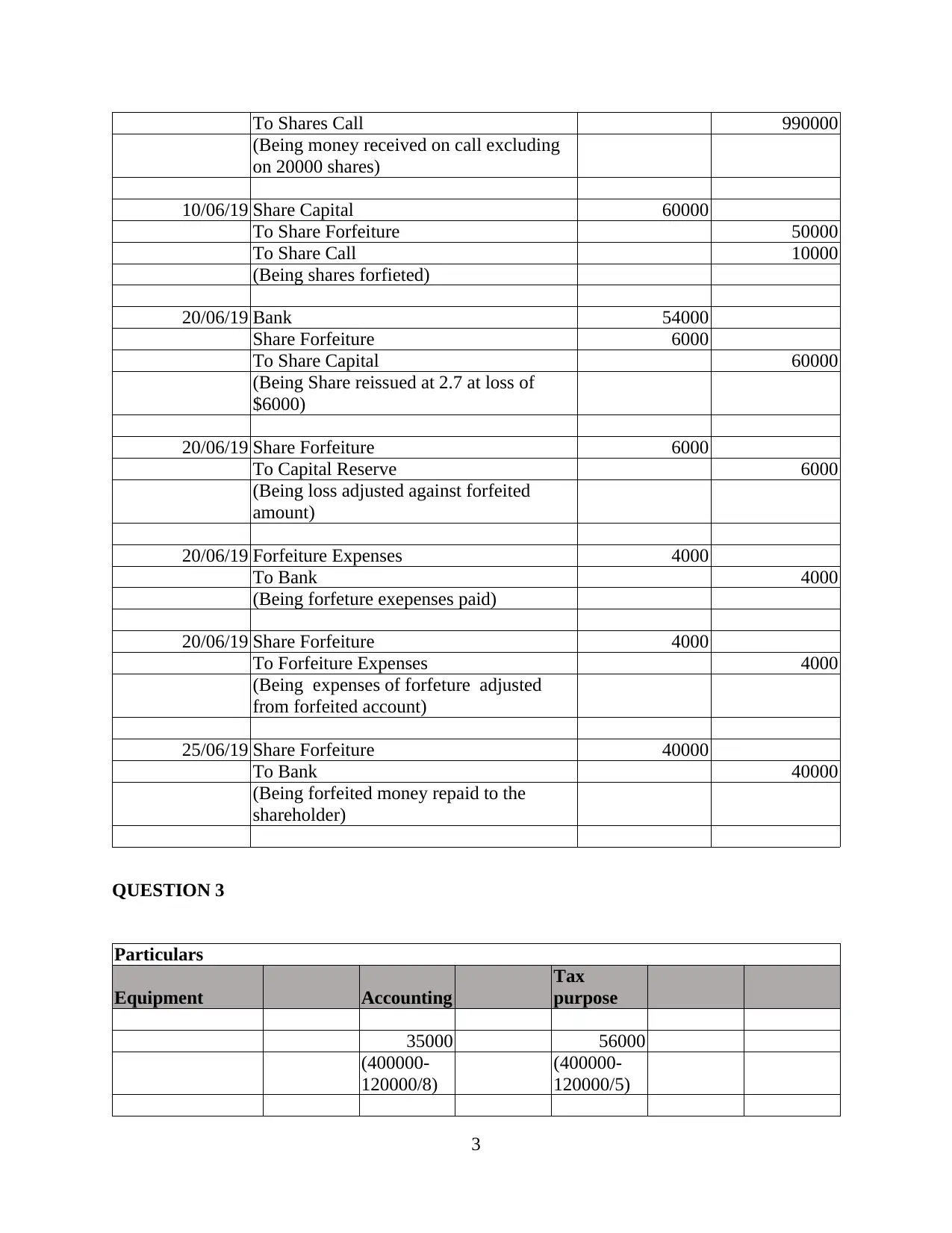
To Shares Call 990000
(Being money received on call excluding
on 20000 shares)
10/06/19 Share Capital 60000
To Share Forfeiture 50000
To Share Call 10000
(Being shares forfieted)
20/06/19 Bank 54000
Share Forfeiture 6000
To Share Capital 60000
(Being Share reissued at 2.7 at loss of
$6000)
20/06/19 Share Forfeiture 6000
To Capital Reserve 6000
(Being loss adjusted against forfeited
amount)
20/06/19 Forfeiture Expenses 4000
To Bank 4000
(Being forfeture exepenses paid)
20/06/19 Share Forfeiture 4000
To Forfeiture Expenses 4000
(Being expenses of forfeture adjusted
from forfeited account)
25/06/19 Share Forfeiture 40000
To Bank 40000
(Being forfeited money repaid to the
shareholder)
QUESTION 3
Particulars
Equipment Accounting
Tax
purpose
35000 56000
(400000-
120000/8)
(400000-
120000/5)
3
(Being money received on call excluding
on 20000 shares)
10/06/19 Share Capital 60000
To Share Forfeiture 50000
To Share Call 10000
(Being shares forfieted)
20/06/19 Bank 54000
Share Forfeiture 6000
To Share Capital 60000
(Being Share reissued at 2.7 at loss of
$6000)
20/06/19 Share Forfeiture 6000
To Capital Reserve 6000
(Being loss adjusted against forfeited
amount)
20/06/19 Forfeiture Expenses 4000
To Bank 4000
(Being forfeture exepenses paid)
20/06/19 Share Forfeiture 4000
To Forfeiture Expenses 4000
(Being expenses of forfeture adjusted
from forfeited account)
25/06/19 Share Forfeiture 40000
To Bank 40000
(Being forfeited money repaid to the
shareholder)
QUESTION 3
Particulars
Equipment Accounting
Tax
purpose
35000 56000
(400000-
120000/8)
(400000-
120000/5)
3
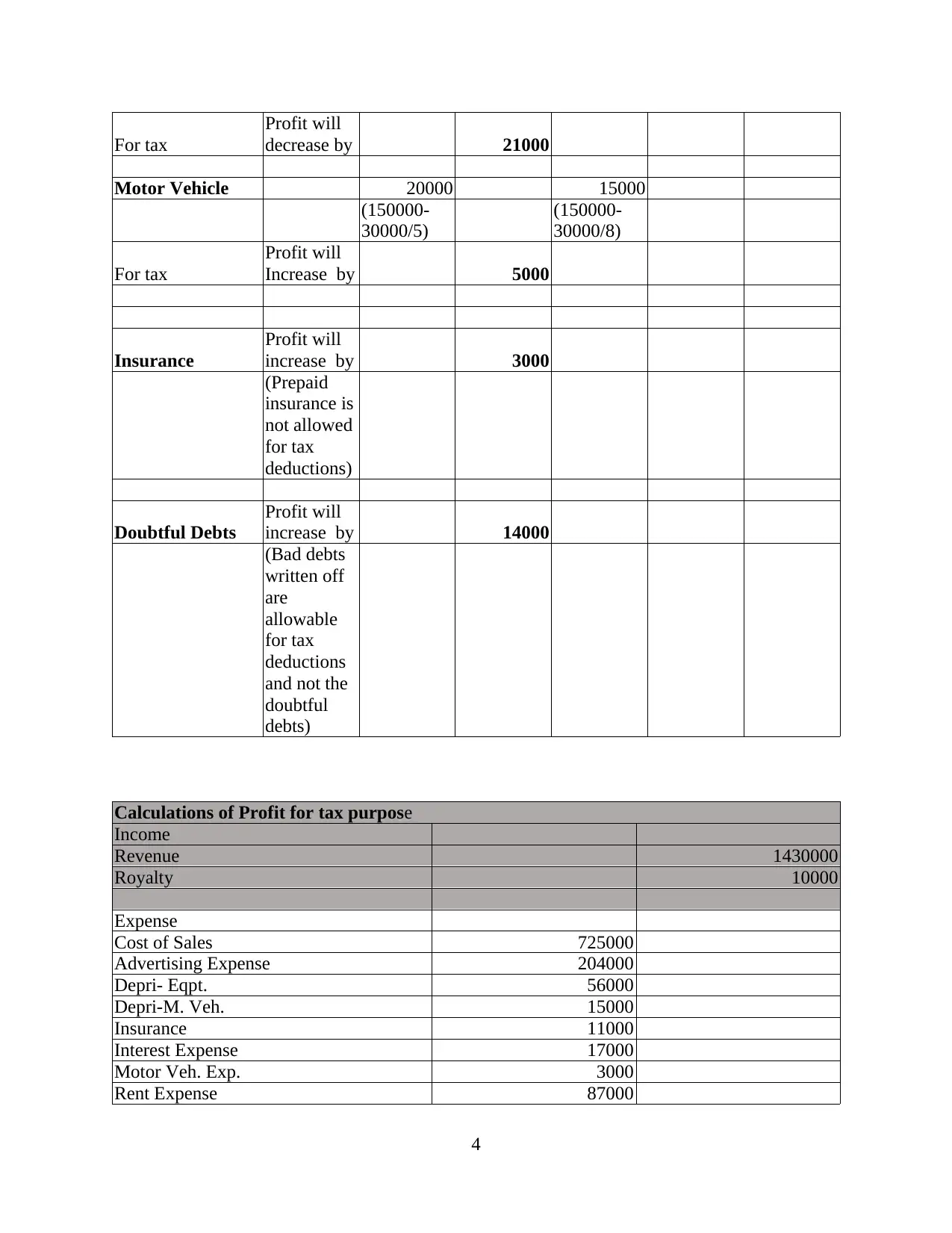
For tax
Profit will
decrease by 21000
Motor Vehicle 20000 15000
(150000-
30000/5)
(150000-
30000/8)
For tax
Profit will
Increase by 5000
Insurance
Profit will
increase by 3000
(Prepaid
insurance is
not allowed
for tax
deductions)
Doubtful Debts
Profit will
increase by 14000
(Bad debts
written off
are
allowable
for tax
deductions
and not the
doubtful
debts)
Calculations of Profit for tax purpose
Income
Revenue 1430000
Royalty 10000
Expense
Cost of Sales 725000
Advertising Expense 204000
Depri- Eqpt. 56000
Depri-M. Veh. 15000
Insurance 11000
Interest Expense 17000
Motor Veh. Exp. 3000
Rent Expense 87000
4
Profit will
decrease by 21000
Motor Vehicle 20000 15000
(150000-
30000/5)
(150000-
30000/8)
For tax
Profit will
Increase by 5000
Insurance
Profit will
increase by 3000
(Prepaid
insurance is
not allowed
for tax
deductions)
Doubtful Debts
Profit will
increase by 14000
(Bad debts
written off
are
allowable
for tax
deductions
and not the
doubtful
debts)
Calculations of Profit for tax purpose
Income
Revenue 1430000
Royalty 10000
Expense
Cost of Sales 725000
Advertising Expense 204000
Depri- Eqpt. 56000
Depri-M. Veh. 15000
Insurance 11000
Interest Expense 17000
Motor Veh. Exp. 3000
Rent Expense 87000
4
⊘ This is a preview!⊘
Do you want full access?
Subscribe today to unlock all pages.

Trusted by 1+ million students worldwide
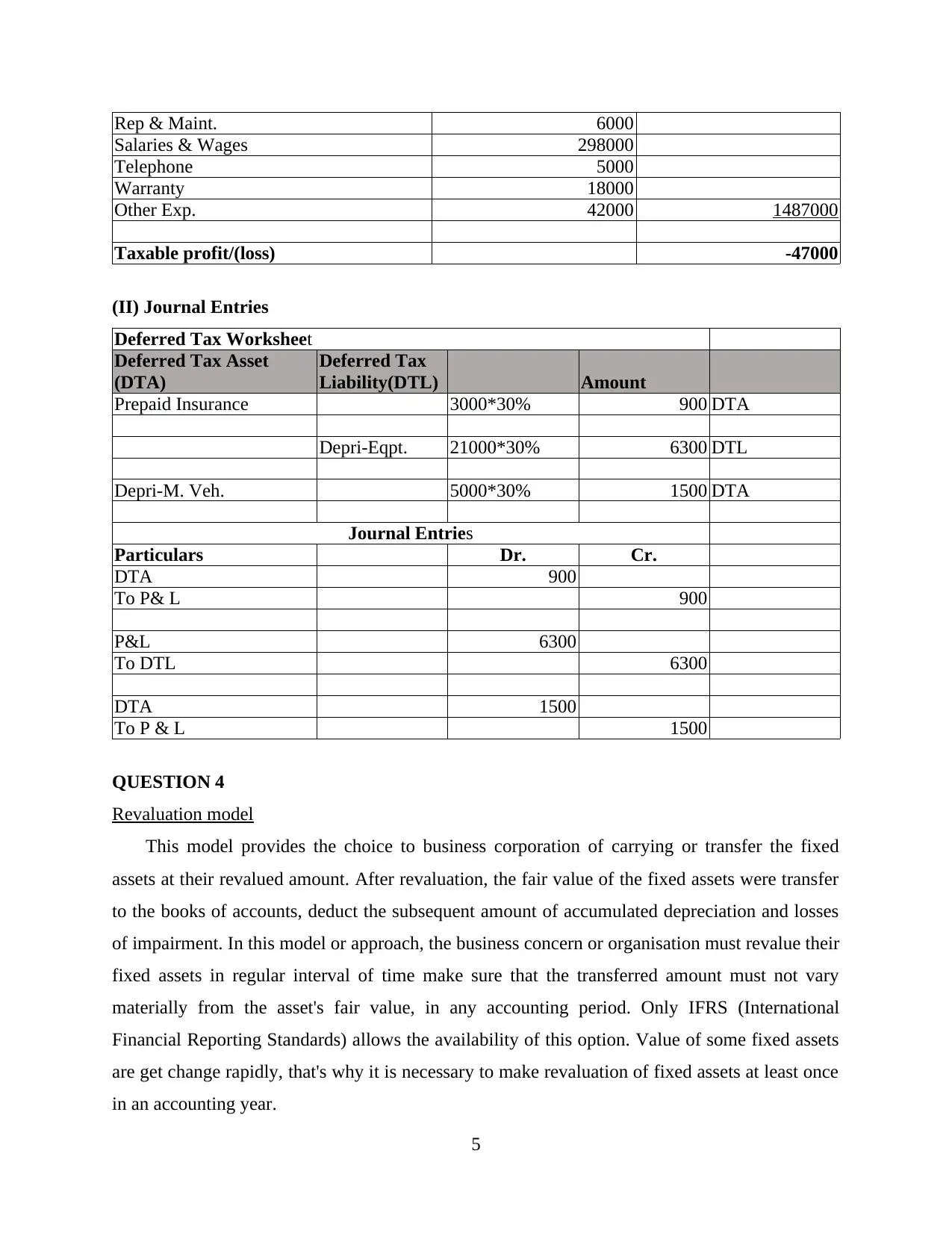
Rep & Maint. 6000
Salaries & Wages 298000
Telephone 5000
Warranty 18000
Other Exp. 42000 1487000
Taxable profit/(loss) -47000
(II) Journal Entries
Deferred Tax Worksheet
Deferred Tax Asset
(DTA)
Deferred Tax
Liability(DTL) Amount
Prepaid Insurance 3000*30% 900 DTA
Depri-Eqpt. 21000*30% 6300 DTL
Depri-M. Veh. 5000*30% 1500 DTA
Journal Entries
Particulars Dr. Cr.
DTA 900
To P& L 900
P&L 6300
To DTL 6300
DTA 1500
To P & L 1500
QUESTION 4
Revaluation model
This model provides the choice to business corporation of carrying or transfer the fixed
assets at their revalued amount. After revaluation, the fair value of the fixed assets were transfer
to the books of accounts, deduct the subsequent amount of accumulated depreciation and losses
of impairment. In this model or approach, the business concern or organisation must revalue their
fixed assets in regular interval of time make sure that the transferred amount must not vary
materially from the asset's fair value, in any accounting period. Only IFRS (International
Financial Reporting Standards) allows the availability of this option. Value of some fixed assets
are get change rapidly, that's why it is necessary to make revaluation of fixed assets at least once
in an accounting year.
5
Salaries & Wages 298000
Telephone 5000
Warranty 18000
Other Exp. 42000 1487000
Taxable profit/(loss) -47000
(II) Journal Entries
Deferred Tax Worksheet
Deferred Tax Asset
(DTA)
Deferred Tax
Liability(DTL) Amount
Prepaid Insurance 3000*30% 900 DTA
Depri-Eqpt. 21000*30% 6300 DTL
Depri-M. Veh. 5000*30% 1500 DTA
Journal Entries
Particulars Dr. Cr.
DTA 900
To P& L 900
P&L 6300
To DTL 6300
DTA 1500
To P & L 1500
QUESTION 4
Revaluation model
This model provides the choice to business corporation of carrying or transfer the fixed
assets at their revalued amount. After revaluation, the fair value of the fixed assets were transfer
to the books of accounts, deduct the subsequent amount of accumulated depreciation and losses
of impairment. In this model or approach, the business concern or organisation must revalue their
fixed assets in regular interval of time make sure that the transferred amount must not vary
materially from the asset's fair value, in any accounting period. Only IFRS (International
Financial Reporting Standards) allows the availability of this option. Value of some fixed assets
are get change rapidly, that's why it is necessary to make revaluation of fixed assets at least once
in an accounting year.
5
Paraphrase This Document
Need a fresh take? Get an instant paraphrase of this document with our AI Paraphraser
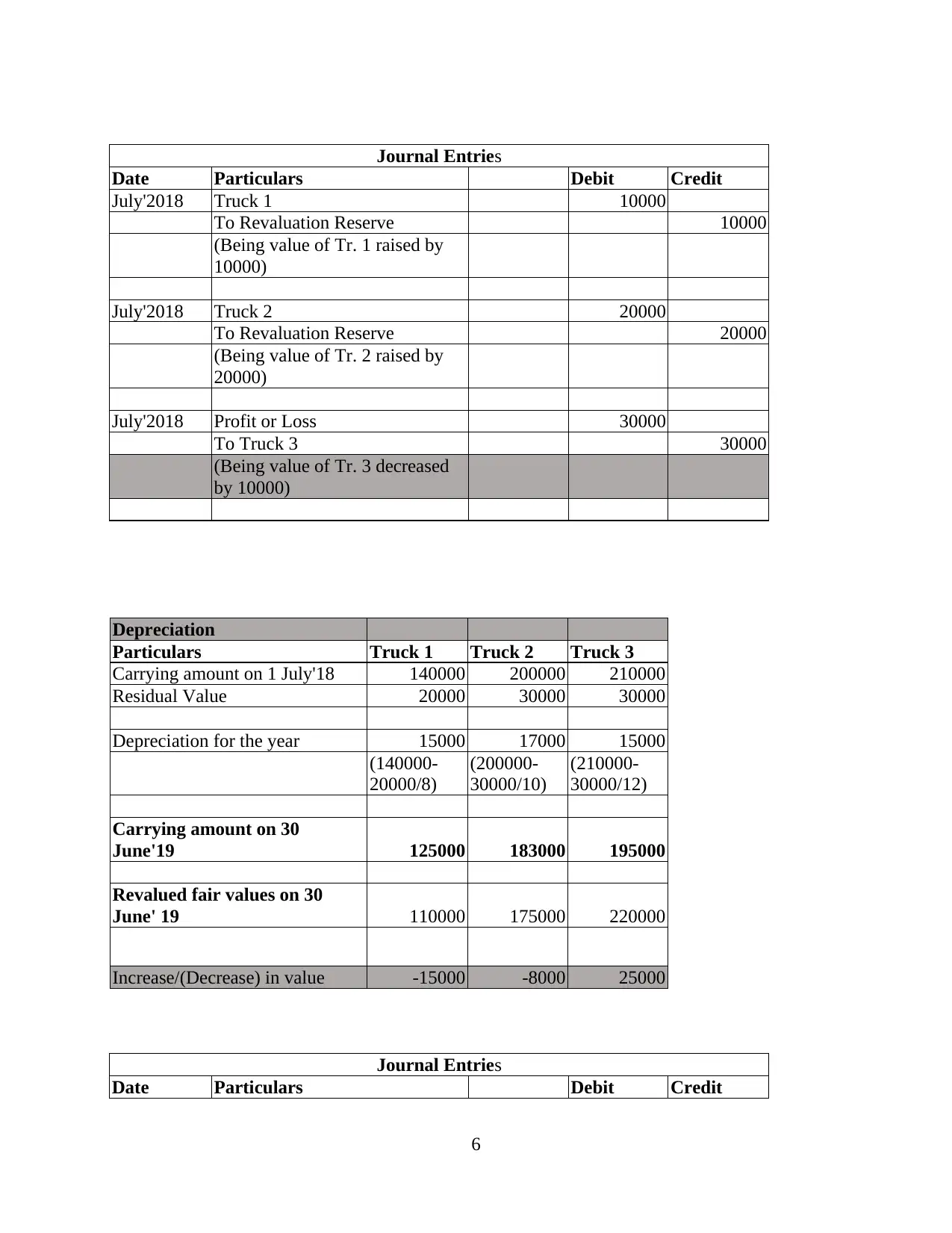
Journal Entries
Date Particulars Debit Credit
July'2018 Truck 1 10000
To Revaluation Reserve 10000
(Being value of Tr. 1 raised by
10000)
July'2018 Truck 2 20000
To Revaluation Reserve 20000
(Being value of Tr. 2 raised by
20000)
July'2018 Profit or Loss 30000
To Truck 3 30000
(Being value of Tr. 3 decreased
by 10000)
Depreciation
Particulars Truck 1 Truck 2 Truck 3
Carrying amount on 1 July'18 140000 200000 210000
Residual Value 20000 30000 30000
Depreciation for the year 15000 17000 15000
(140000-
20000/8)
(200000-
30000/10)
(210000-
30000/12)
Carrying amount on 30
June'19 125000 183000 195000
Revalued fair values on 30
June' 19 110000 175000 220000
Increase/(Decrease) in value -15000 -8000 25000
Journal Entries
Date Particulars Debit Credit
6
Date Particulars Debit Credit
July'2018 Truck 1 10000
To Revaluation Reserve 10000
(Being value of Tr. 1 raised by
10000)
July'2018 Truck 2 20000
To Revaluation Reserve 20000
(Being value of Tr. 2 raised by
20000)
July'2018 Profit or Loss 30000
To Truck 3 30000
(Being value of Tr. 3 decreased
by 10000)
Depreciation
Particulars Truck 1 Truck 2 Truck 3
Carrying amount on 1 July'18 140000 200000 210000
Residual Value 20000 30000 30000
Depreciation for the year 15000 17000 15000
(140000-
20000/8)
(200000-
30000/10)
(210000-
30000/12)
Carrying amount on 30
June'19 125000 183000 195000
Revalued fair values on 30
June' 19 110000 175000 220000
Increase/(Decrease) in value -15000 -8000 25000
Journal Entries
Date Particulars Debit Credit
6
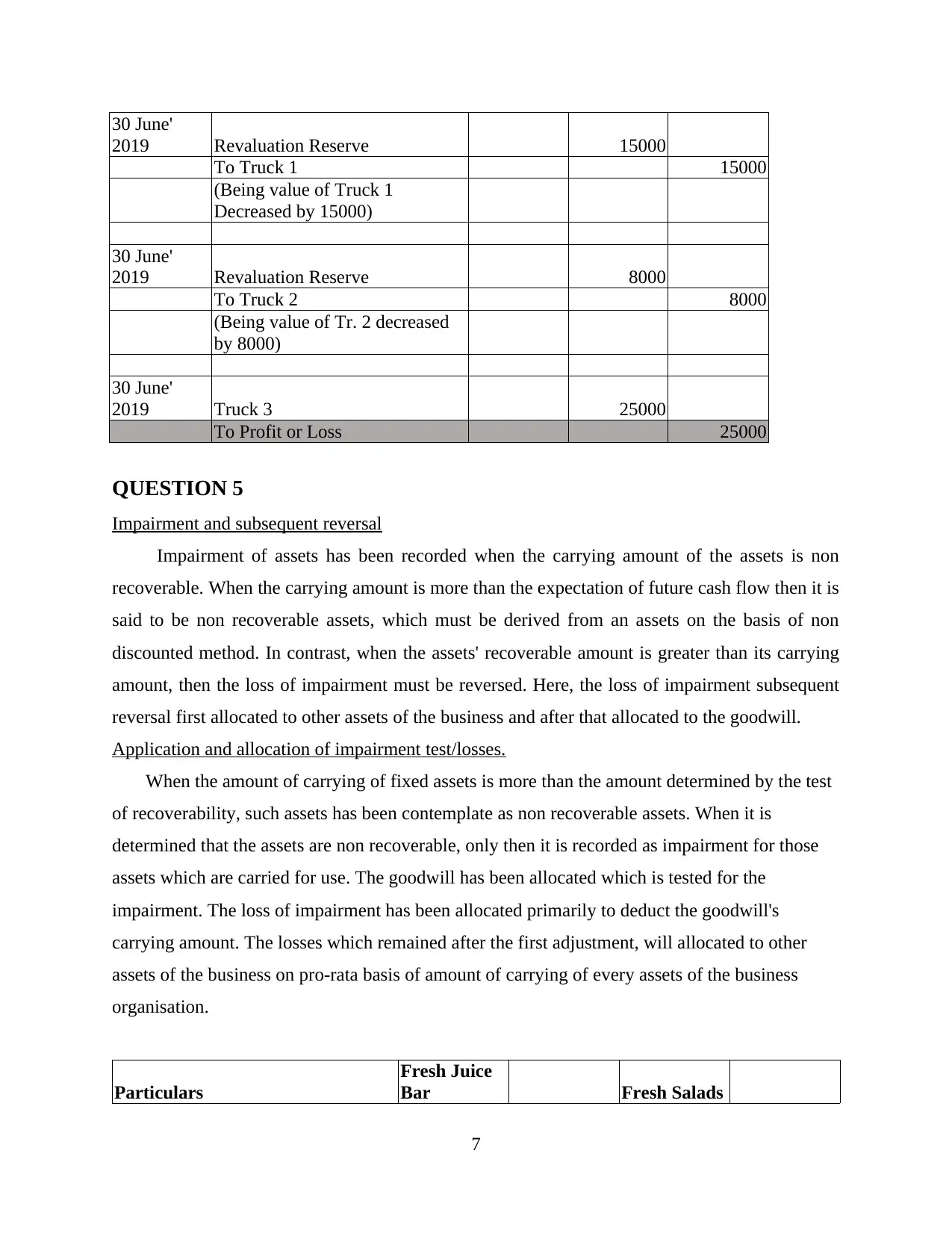
30 June'
2019 Revaluation Reserve 15000
To Truck 1 15000
(Being value of Truck 1
Decreased by 15000)
30 June'
2019 Revaluation Reserve 8000
To Truck 2 8000
(Being value of Tr. 2 decreased
by 8000)
30 June'
2019 Truck 3 25000
To Profit or Loss 25000
QUESTION 5
Impairment and subsequent reversal
Impairment of assets has been recorded when the carrying amount of the assets is non
recoverable. When the carrying amount is more than the expectation of future cash flow then it is
said to be non recoverable assets, which must be derived from an assets on the basis of non
discounted method. In contrast, when the assets' recoverable amount is greater than its carrying
amount, then the loss of impairment must be reversed. Here, the loss of impairment subsequent
reversal first allocated to other assets of the business and after that allocated to the goodwill.
Application and allocation of impairment test/losses.
When the amount of carrying of fixed assets is more than the amount determined by the test
of recoverability, such assets has been contemplate as non recoverable assets. When it is
determined that the assets are non recoverable, only then it is recorded as impairment for those
assets which are carried for use. The goodwill has been allocated which is tested for the
impairment. The loss of impairment has been allocated primarily to deduct the goodwill's
carrying amount. The losses which remained after the first adjustment, will allocated to other
assets of the business on pro-rata basis of amount of carrying of every assets of the business
organisation.
Particulars
Fresh Juice
Bar Fresh Salads
7
2019 Revaluation Reserve 15000
To Truck 1 15000
(Being value of Truck 1
Decreased by 15000)
30 June'
2019 Revaluation Reserve 8000
To Truck 2 8000
(Being value of Tr. 2 decreased
by 8000)
30 June'
2019 Truck 3 25000
To Profit or Loss 25000
QUESTION 5
Impairment and subsequent reversal
Impairment of assets has been recorded when the carrying amount of the assets is non
recoverable. When the carrying amount is more than the expectation of future cash flow then it is
said to be non recoverable assets, which must be derived from an assets on the basis of non
discounted method. In contrast, when the assets' recoverable amount is greater than its carrying
amount, then the loss of impairment must be reversed. Here, the loss of impairment subsequent
reversal first allocated to other assets of the business and after that allocated to the goodwill.
Application and allocation of impairment test/losses.
When the amount of carrying of fixed assets is more than the amount determined by the test
of recoverability, such assets has been contemplate as non recoverable assets. When it is
determined that the assets are non recoverable, only then it is recorded as impairment for those
assets which are carried for use. The goodwill has been allocated which is tested for the
impairment. The loss of impairment has been allocated primarily to deduct the goodwill's
carrying amount. The losses which remained after the first adjustment, will allocated to other
assets of the business on pro-rata basis of amount of carrying of every assets of the business
organisation.
Particulars
Fresh Juice
Bar Fresh Salads
7
⊘ This is a preview!⊘
Do you want full access?
Subscribe today to unlock all pages.

Trusted by 1+ million students worldwide

Motor Vehicles
Fair Value 11000 14000
Cost 35000 18000
Impairment Loss 24000 4000
Cost of Business
Valuer in Use 58000 180000
Cost to Sell 50000 140000
Impairment Loss 8000 40000
Journal Entries
Impairmentg loss 24000 4000
To Motor Vehicle 24000 4000
Impairment Loss 8000
To Fresh Juice Bar 8000
Impairment Loss 40000
To Fresh Salads 40000
8
Fair Value 11000 14000
Cost 35000 18000
Impairment Loss 24000 4000
Cost of Business
Valuer in Use 58000 180000
Cost to Sell 50000 140000
Impairment Loss 8000 40000
Journal Entries
Impairmentg loss 24000 4000
To Motor Vehicle 24000 4000
Impairment Loss 8000
To Fresh Juice Bar 8000
Impairment Loss 40000
To Fresh Salads 40000
8
1 out of 10
Related Documents
Your All-in-One AI-Powered Toolkit for Academic Success.
+13062052269
info@desklib.com
Available 24*7 on WhatsApp / Email
![[object Object]](/_next/static/media/star-bottom.7253800d.svg)
Unlock your academic potential
Copyright © 2020–2025 A2Z Services. All Rights Reserved. Developed and managed by ZUCOL.

